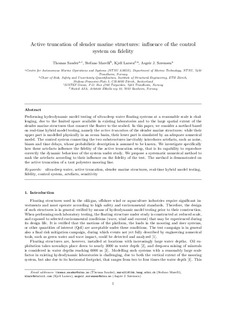| dc.contributor.author | Sauder, Thomas Michel | |
| dc.contributor.author | Marelli, Stefano | |
| dc.contributor.author | Larsen, Kjell | |
| dc.contributor.author | Sørensen, Asgeir Johan | |
| dc.date.accessioned | 2018-04-26T12:32:56Z | |
| dc.date.available | 2018-04-26T12:32:56Z | |
| dc.date.created | 2018-04-01T10:25:52Z | |
| dc.date.issued | 2018-05 | |
| dc.identifier.citation | Applied Ocean Research. 2018, 154-169. | nb_NO |
| dc.identifier.issn | 0141-1187 | |
| dc.identifier.uri | http://hdl.handle.net/11250/2496168 | |
| dc.description.abstract | Performing hydrodynamic model testing of ultra-deep water floating systems at a reasonable scale ischallenging, due to the limited space available in existing laboratories and to the large spatial extent ofthe slender marine structures that connect the floater to the seabed. In this paper, we consider a methodbased on real-time hybrid model testing, namely the active truncation of the slender marine structures:while their upper part is modelled physically in an ocean basin, their lower part is simulated by anadequate numerical model. The control system connecting the two substructures inevitably introducesartefacts, such as noise, biases and time delays, whose probabilistic description is assumed to be known.We investigate specifically how these artefacts influence the fidelity of the active truncation setup, thatis its capability to reproduce correctly the dynamic behaviour of the system under study. We propose asystematic numerical method to rank the artefacts according to their influence on the fidelity of the test.The method is demonstrated on the active truncation of a taut polyester mooring line. | nb_NO |
| dc.language.iso | eng | nb_NO |
| dc.rights | Attribution-NonCommercial-NoDerivatives 4.0 Internasjonal | * |
| dc.rights.uri | http://creativecommons.org/licenses/by-nc-nd/4.0/deed.no | * |
| dc.subject | Ultra-deep water | nb_NO |
| dc.subject | Active truncation | nb_NO |
| dc.subject | Slender marine structures | nb_NO |
| dc.subject | Real-time hybrid model testing | nb_NO |
| dc.subject | Fidelity | nb_NO |
| dc.subject | Control system | nb_NO |
| dc.subject | Artefacts | nb_NO |
| dc.subject | Sensitivity | nb_NO |
| dc.title | Active truncation of slender marine structures: Influence of thecontrol system on Fidelity | nb_NO |
| dc.type | Journal article | nb_NO |
| dc.type | Peer reviewed | nb_NO |
| dc.description.version | acceptedVersion | nb_NO |
| dc.rights.holder | Postprint version © 2018 the authors | nb_NO |
| dc.source.pagenumber | 154-169 | nb_NO |
| dc.source.journal | Applied Ocean Research | nb_NO |
| dc.identifier.doi | 10.1016/j.apor.2018.02.023 | |
| dc.identifier.cristin | 1576407 | |
| dc.relation.project | Norges forskningsråd: 223254 | nb_NO |
| dc.relation.project | Norges forskningsråd: 254845 | nb_NO |
| cristin.unitcode | 7566,8,0,0 | |
| cristin.unitname | Ocean Engineering | |
| cristin.ispublished | true | |
| cristin.fulltext | postprint | |
| cristin.qualitycode | 1 | |

